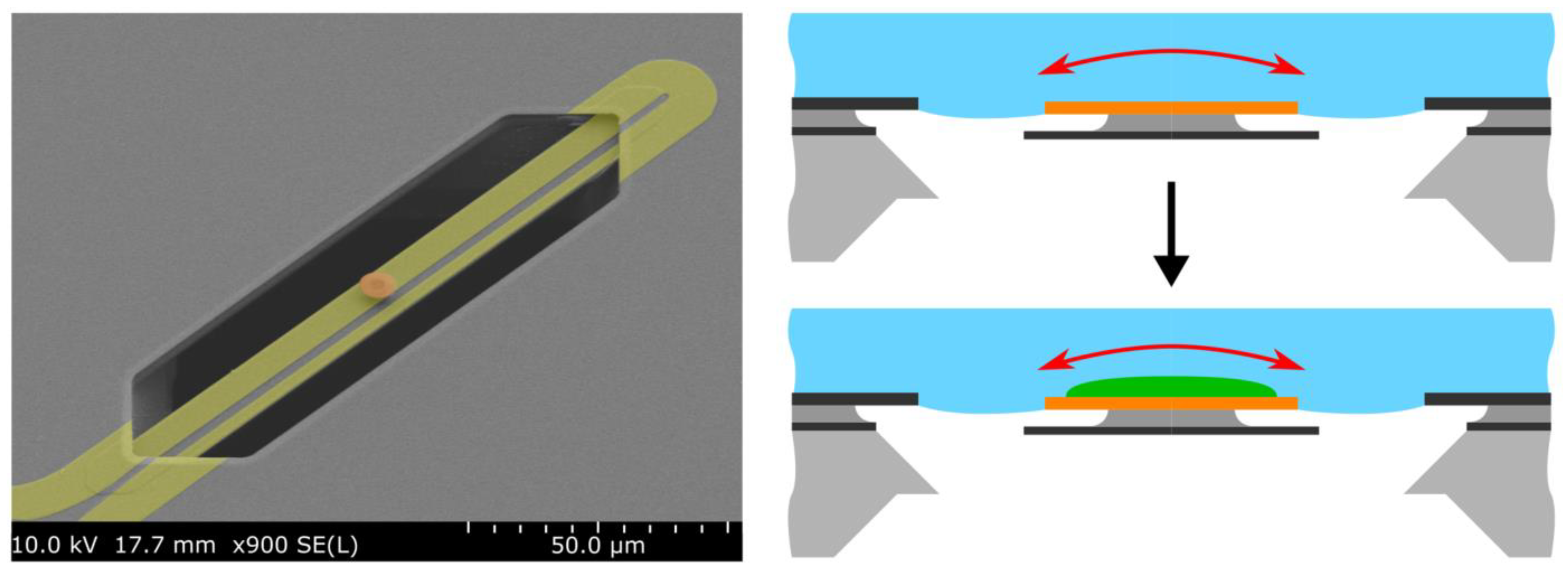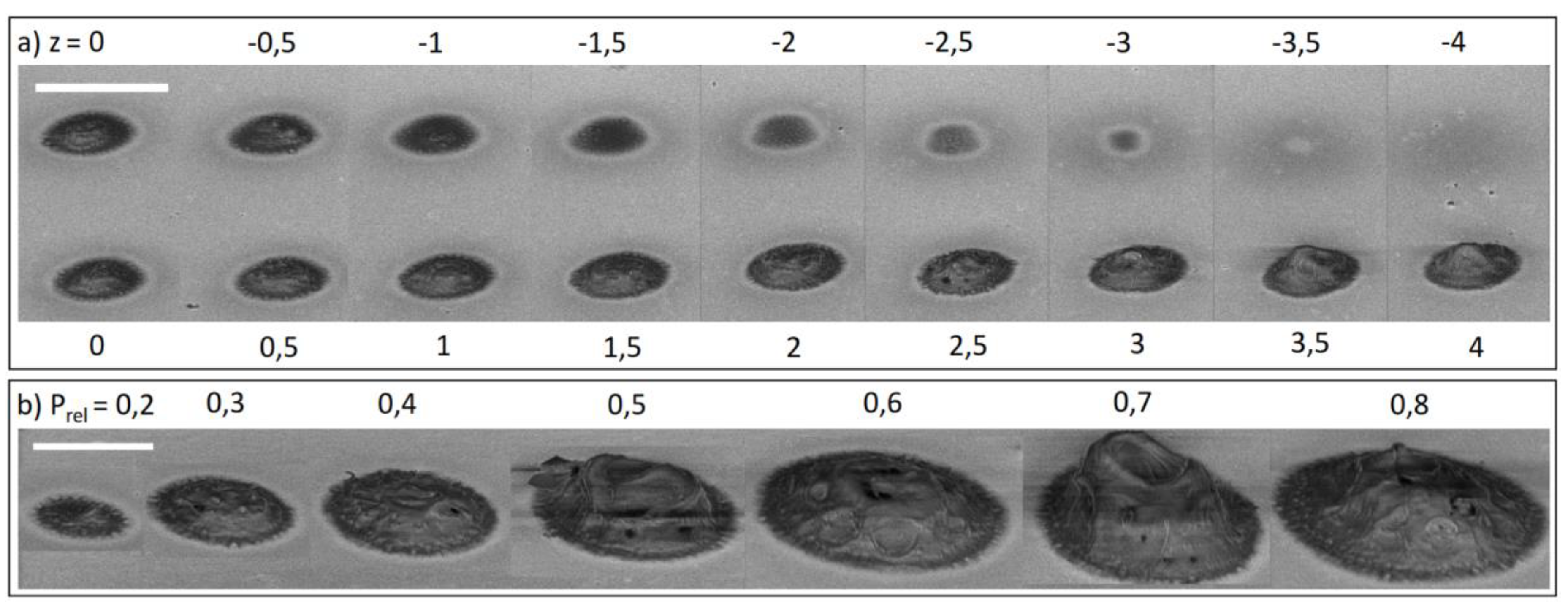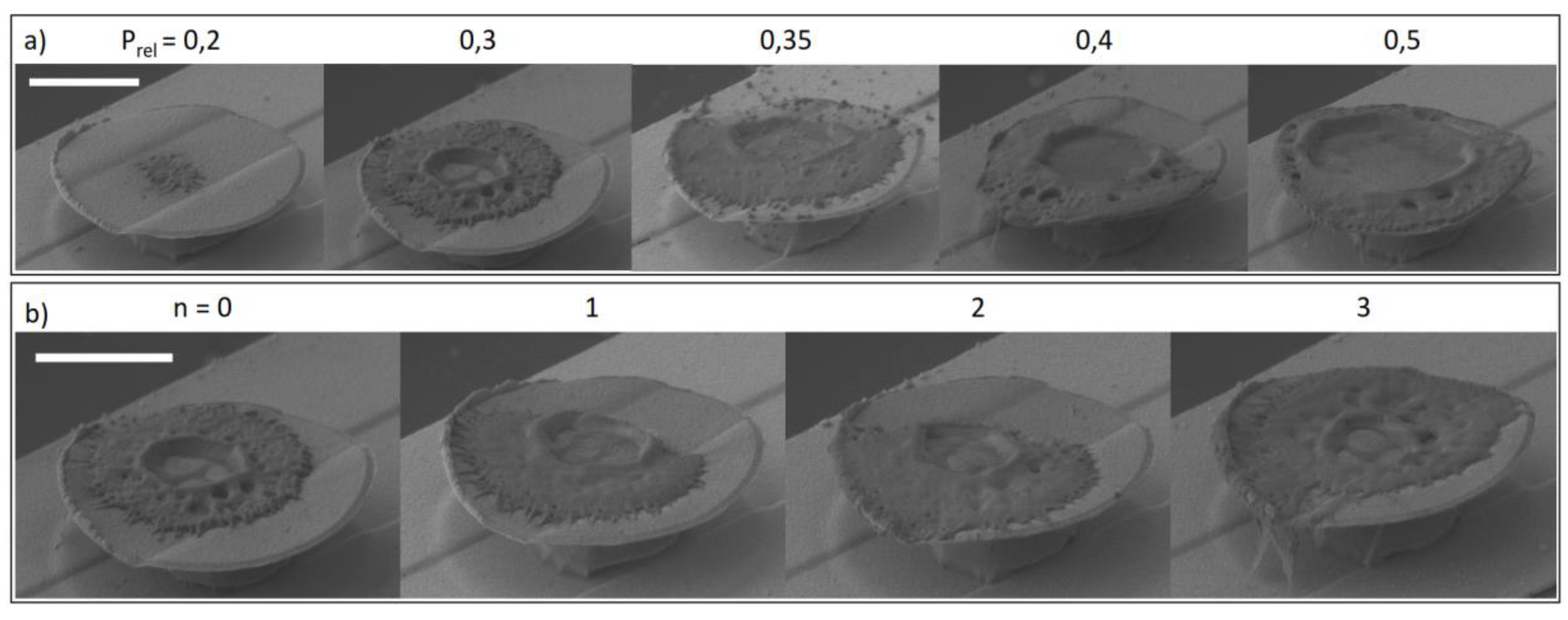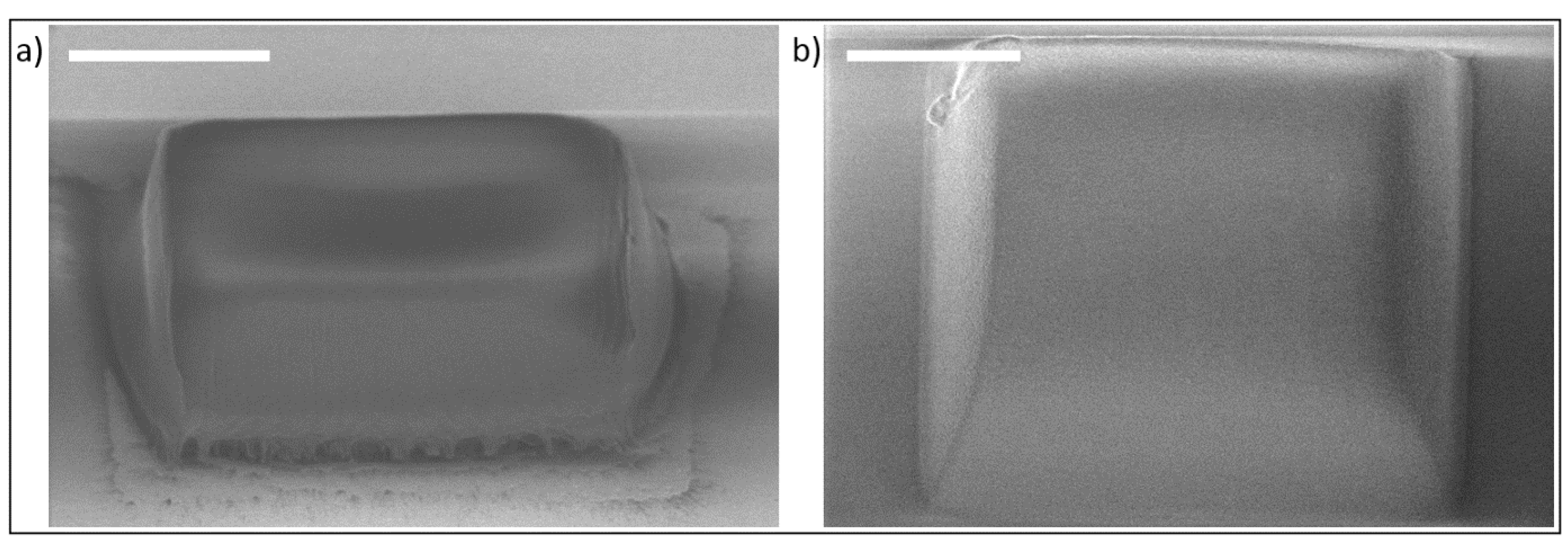Exploiting Direct Laser Writing for Hydrogel Integration into Fragile Microelectromechanical Systems
Abstract
1. Introduction
2. Materials and Methods
3. Results
4. Conclusions
Author Contributions
Funding
Acknowledgments
Conflicts of Interest
References
- Bilia, A.; Carelli, V.; di Colo, G.; Nannipieri, E. In vitro evaluation of a pH-sensitive hydrogel for control of GI drug delivery from silicone-based matrices. Int. J. Pharm. 1996, 130, 83–92. [Google Scholar] [CrossRef]
- Bashir, R.; Hilt, J.Z.; Elibol, O.; Gupta, A.; Peppas, N.A. Micromechanical cantilever as an ultrasensitive pH microsensor. Appl. Phys. Lett. 2002, 81, 3091–3093. [Google Scholar] [CrossRef]
- Beebe, D.J.; Moore, J.S.; Bauer, J.M.; Yu, Q.; Liu, R.H.; Devadoss, C.; Jo, B.-H. Functional hydrogel structures for autonomous flow control inside microfluidic channels. Nature 2000, 404, 588–590. [Google Scholar] [CrossRef]
- Cai, Q.Y.; Grimes, C.A. A remote query magnetoelastic pH sensor. Sens. Actuators B Chem. 2000, 71, 112–117. [Google Scholar] [CrossRef]
- Dong, L.-C.; Hoffman, A.S. A novel approach for preparation of pH-sensitive hydrogels for enteric drug delivery. J. Control. Release 1991, 15, 141–152. [Google Scholar] [CrossRef]
- Harnish, B.; Robinson, J.T.; Pei, Z.; Ramström, O.; Yan, M. UV-Cross-Linked Poly(vinylpyridine) Thin Films as Reversibly Responsive Surfaces. Chem. Mater. 2005, 17, 4092–4096. [Google Scholar] [CrossRef]
- Hilt, J.Z.; Gupta, A.K.; Bashir, R.; Peppas, N.A. Ultrasensitive Biomems Sensors Based on Microcantilevers Patterned with Environmentally Responsive Hydrogels. Biomed. Microdevices 2003, 5, 177–184. [Google Scholar] [CrossRef]
- Hoffmann, J.; Plötner, M.; Kuckling, D.; Fischer, W.-J. Photopatterning of thermally sensitive hydrogels useful for microactuators. Sens. Actuators A Phys. 1999, 77, 139–144. [Google Scholar] [CrossRef]
- Han, M.-H.; Kim, J.-W.; Kim, J.; Ko, J.Y.; Magda, J.J.; Han, I.S. Temperature-dependent transparency of poly(HPMA-co-DMA) hydrogels: Effect of synthesis parameters. Polymer 2003, 44, 4541–4546. [Google Scholar] [CrossRef]
- Fenzl, C.; Wilhelm, S.; Hirsch, T.; Wolfbeis, O.S. Optical sensing of the ionic strength using photonic crystals in a hydrogel matrix. ACS Appl. Mater. Interfaces 2013, 5, 173–178. [Google Scholar] [CrossRef]
- Zhao, B.; Moore, J.S. Fast pH- and Ionic Strength-Responsive Hydrogels in Microchannels. Langmuir 2001, 17, 4758–4763. [Google Scholar] [CrossRef]
- Mamada, A.; Tanaka, T.; Kungwatchakun, D.; Irie, M. Photoinduced phase transition of gels. Macromolecules 1990, 23, 1517–1519. [Google Scholar] [CrossRef]
- Alexeev, V.L.; Sharma, A.C.; Goponenko, A.V.; Das, S.; Lednev, I.K.; Wilcox, C.S.; Finegold, D.N.; Asher, S.A. High Ionic Strength Glucose-Sensing Photonic Crystal. Anal. Chem. 2003, 75, 2316–2323. [Google Scholar] [CrossRef]
- Chen, Z.; Hua, Z.; Xu, L.; Huang, Y.; Zhao, M.; Li, Y. Protein-responsive imprinted polymers with specific shrinking and rebinding. J. Mol. Recognit. 2008, 21, 71–77. [Google Scholar] [CrossRef] [PubMed]
- Gabai, R.; Sallacan, N.; Chegel, V.; Bourenko, T.; Katz, E.; Willner, I. Characterization of the Swelling of Acrylamidophenylboronic Acid−Acrylamide Hydrogels upon Interaction with Glucose by Faradaic Impedance Spectroscopy, Chronopotentiometry, Quartz-Crystal Microbalance (QCM), and Surface Plasmon Resonance (SPR) Experiments. J. Phys. Chem. B 2001, 105, 8196–8202. [Google Scholar] [CrossRef]
- Lavine, B.K.; Westover, D.J.; Kaval, N.; Mirjankar, N.; Oxenford, L.; Mwangi, G.K. Swellable molecularly imprinted polyN-(N-propyl)acrylamide particles for detection of emerging organic contaminants using surface plasmon resonance spectroscopy. Talanta 2007, 72, 1042–1048. [Google Scholar] [CrossRef]
- Miyata, T.; Asami, N.; Uragami, T. Areversibly antigen-responsive hydrogel. Nature 1999, 399, 766–769. [Google Scholar] [CrossRef]
- Richter, A.; Paschew, G.; Klatt, S.; Lienig, J.; Arndt, K.-F.; Adler, H.-J.P. Review on Hydrogel-based pH Sensors and Microsensors. Sensors 2008, 8, 561–581. [Google Scholar] [CrossRef] [PubMed]
- Tokarev, I.; Minko, S. Stimuli-responsive hydrogel thin films. Soft Matter. 2009, 5, 511–524. [Google Scholar] [CrossRef]
- Goponenko, A.V.; Dzenis, Y.A. Role of Mechanical Factors in Applications of Stimuli-Responsive Polymer Gels—Status and Prospects. Polymer 2016, 101, 415–449. [Google Scholar] [CrossRef]
- Ma, S.; Yu, B.; Pei, X.; Zhou, F. Structural hydrogels. Polymer 2016, 98, 516–535. [Google Scholar] [CrossRef]
- Revzin, A.; Russell, R.J.; Yadavalli, V.K.; Koh, W.-G.; Deister, C.; Hile, D.D.; Mellott, M.B.; Pishko, M.V. Fabrication of Poly(ethylene glycol) Hydrogel Microstructures Using Photolithography. Langmuir 2001, 17, 5440–5447. [Google Scholar] [CrossRef]
- Chandra, D.; Taylor, J.A.; Yang, S. Replica molding of high-aspect-ratio (sub-)micron hydrogel pillar arrays and their stability in air and solvents. Soft Matter. 2008, 4, 979. [Google Scholar] [CrossRef]
- Di Benedetto, F.; Biasco, A.; Pisignano, D.; Cingolani, R. Patterning polyacrylamide hydrogels by soft lithography. Nanotechnology 2005, 16, S165–S170. [Google Scholar] [CrossRef]
- Lei, M.; Gu, Y.; Baldi, A.; Siegel, R.A.; Ziaie, B. High-resolution technique for fabricating environmentally sensitive hydrogel microstructures. Langmuir 2004, 20, 8947–8951. [Google Scholar] [CrossRef]
- Menges, J.; Kleinschmidt, P.; Bart, H.-J.; Oesterschulze, E. A precision structured smart hydrogel for sensing applications. J. Appl. Phys. 2017, 122, 134501. [Google Scholar] [CrossRef]
- Maruo, S.; Nakamura, O.; Kawata, S. Three-dimensional microfabrication with two-photon-absorbed photopolymerization. Opt. Lett. 1997, 22, 132. [Google Scholar] [CrossRef]
- Hohmann, J.K.; Renner, M.; Waller, E.H.; von Freymann, G. Three-Dimensional μ-Printing: An Enabling Technology. Adv. Opt. Mat. 2015, 3, 1488–1507. [Google Scholar] [CrossRef]
- Kaehr, B.; Shear, J.B. Multiphoton fabrication of chemically responsive protein hydrogels for microactuation. Proc. Natl. Acad. Sci. USA 2008, 105, 8850–8854. [Google Scholar] [CrossRef]
- Brigo, L.; Urciuolo, A.; Giulitti, S.; Della Giustina, G.; Tromayer, M.; Liska, R.; Elvassore, N.; Brusatin, G. 3D high-resolution two-photon crosslinked hydrogel structures for biological studies. Acta Biomater. 2017, 55, 373–384. [Google Scholar] [CrossRef]
- Käpylä, E.; Sedlačík, T.; Aydogan, D.B.; Viitanen, J.; Rypáček, F.; Kellomäki, M. Direct laser writing of synthetic poly(amino acid) hydrogels and poly(ethylene glycol) diacrylates by two-photon polymerization. Mater. Sci. Eng. C 2014, 43, 280–289. [Google Scholar] [CrossRef]
- Pitts, J.D.; Campagnola, P.J.; Epling, G.A.; Goodman, S.L. Submicron Multiphoton Free-Form Fabrication of Proteins and Polymers: Studies of Reaction Efficiencies and Applications in Sustained Release. Macromolecules 2000, 33, 1514–1523. [Google Scholar] [CrossRef]
- Torgersen, J.; Qin, X.-H.; Li, Z.; Ovsianikov, A.; Liska, R.; Stampfl, J. Hydrogels for Two-Photon Polymerization: A Toolbox for Mimicking the Extracellular Matrix. Adv. Funct. Mater. 2013, 23, 4542–4554. [Google Scholar] [CrossRef]
- Zarzar, L.D.; Kim, P.; Kolle, M.; Brinker, C.J.; Aizenberg, J.; Kaehr, B. Direct writing and actuation of three-dimensionally patterned hydrogel pads on micropillar supports. Angew. Chem. Int. Ed. 2011, 50, 9356–9360. [Google Scholar] [CrossRef]
- Watanabe, T.; Akiyama, M.; Totani, K.; Kuebler, S.M.; Stellacci, F.; Wenseleers, W.; Braun, K.; Marder, S.R.; Perry, J.W. Photoresponsive Hydrogel Microstructure Fabricated by Two-Photon Initiated Polymerization. Adv. Funct. Mater. 2002, 12, 611–614. [Google Scholar] [CrossRef]
- Peiker, P.; Oesterschulze, E. Geometrically tuned wettability of dynamic micromechanical sensors for an improved in-liquid operation. Appl. Phys. Lett. 2015, 107, 101903. [Google Scholar] [CrossRef]
- Sader, J.E. Frequency response of cantilever beams immersed in viscous fluids with applications to the atomic force microscope. J. Appl. Phys. 1998, 84, 64–76. [Google Scholar] [CrossRef]
- Peiker, P. Entwicklung, Modellierung und Applikation eines Partiell Benetzten Mikromechanischen Resonators für die Zeitaufgelöste Subpikogramm-Massensensorik in Flüssigkeiten. Ph.D. Thesis, TU Kaiserslautern, Kaiserslautern, Germany, 2015. [Google Scholar]
- Waller, E.H.; von Freymann, G.; Waller, E. Spatio-Temporal Proximity Characteristics in 3D μ-Printing via Multi-Photon Absorption. Polymers 2016, 8, 297. [Google Scholar] [CrossRef]
- Hacker, M.; Nawaz, H. Multi-Functional Macromers for Hydrogel Design in Biomedical Engineering and Regenerative Medicine. Int. J. Mol. Sci. 2015, 16, 27677–27706. [Google Scholar] [CrossRef]
- Smets, G.; Hous, P.; Deval, N. Cyclopolymerization. IV. Structure of polymethacrylic anhydride and kinetics of polymerization of methacrylic anhydride. J. Pol. Sci. A 1964, 2, 4825–4834. [Google Scholar] [CrossRef]
- Fischer, J.; Mueller, J.B.; Kaschke, J.; Wolf, T.J.A.; Unterreiner, A.-N.; Wegener, M. Three-dimensional multi-photon direct laser writing with variable repetition rate. Opt. Express 2013, 21, 26244–26260. [Google Scholar] [CrossRef] [PubMed]
- Haske, W.; Chen, V.W.; Hales, J.M.; Dong, W.; Barlow, S.; Marder, S.R.; Perry, J.W. 65 nm feature sizes using visible wavelength 3-D multiphoton lithography. Opt. Express 2007, 15, 3426. [Google Scholar] [CrossRef] [PubMed]
- LaFratta, C.N.; Fourkas, J.T.; Baldacchini, T.; Farrer, R.A. Multiphoton Fabrication. Angew. Chem. Int. Ed. 2007, 46, 6238–6258. [Google Scholar] [CrossRef] [PubMed]






| Abbreviation | Crosslinker | MAA | NIPA |
|---|---|---|---|
| M1 | 1 | 1 | |
| M2 | 1 | 6 | 4 |
| Abbr. | Macromer | Macromer (mg) | BAPO (mg) | DMSO (µL) | MAA (µL) | HEMA (µL) | MAAA (µL) | MMAES (µL) |
|---|---|---|---|---|---|---|---|---|
| R1 | M1 | 80 | 12 | 50 | 50 | 200 | ||
| R2 | M2 | 90 | 12 | 100 | 300 | 300 | ||
| R3 | M1 | 80 | 12 | 250 |
| Air | Citric acid a | Citric acid b | Na2HPO4 b | |
|---|---|---|---|---|
| Resonance frequency (kHz) | 1939 | 1919 | 1120 | 969 |
| Variance (kHz) | <1 | n/a | 17 | 16 |
© 2019 by the authors. Licensee MDPI, Basel, Switzerland. This article is an open access article distributed under the terms and conditions of the Creative Commons Attribution (CC BY) license (http://creativecommons.org/licenses/by/4.0/).
Share and Cite
Menges, J.; Klingel, S.; Oesterschulze, E.; Bart, H.-J. Exploiting Direct Laser Writing for Hydrogel Integration into Fragile Microelectromechanical Systems. Sensors 2019, 19, 2494. https://doi.org/10.3390/s19112494
Menges J, Klingel S, Oesterschulze E, Bart H-J. Exploiting Direct Laser Writing for Hydrogel Integration into Fragile Microelectromechanical Systems. Sensors. 2019; 19(11):2494. https://doi.org/10.3390/s19112494
Chicago/Turabian StyleMenges, Julian, Steffen Klingel, Egbert Oesterschulze, and Hans-Jörg Bart. 2019. "Exploiting Direct Laser Writing for Hydrogel Integration into Fragile Microelectromechanical Systems" Sensors 19, no. 11: 2494. https://doi.org/10.3390/s19112494
APA StyleMenges, J., Klingel, S., Oesterschulze, E., & Bart, H.-J. (2019). Exploiting Direct Laser Writing for Hydrogel Integration into Fragile Microelectromechanical Systems. Sensors, 19(11), 2494. https://doi.org/10.3390/s19112494





